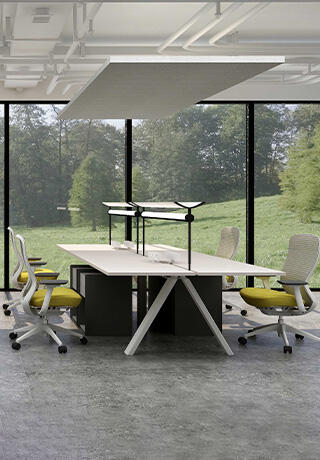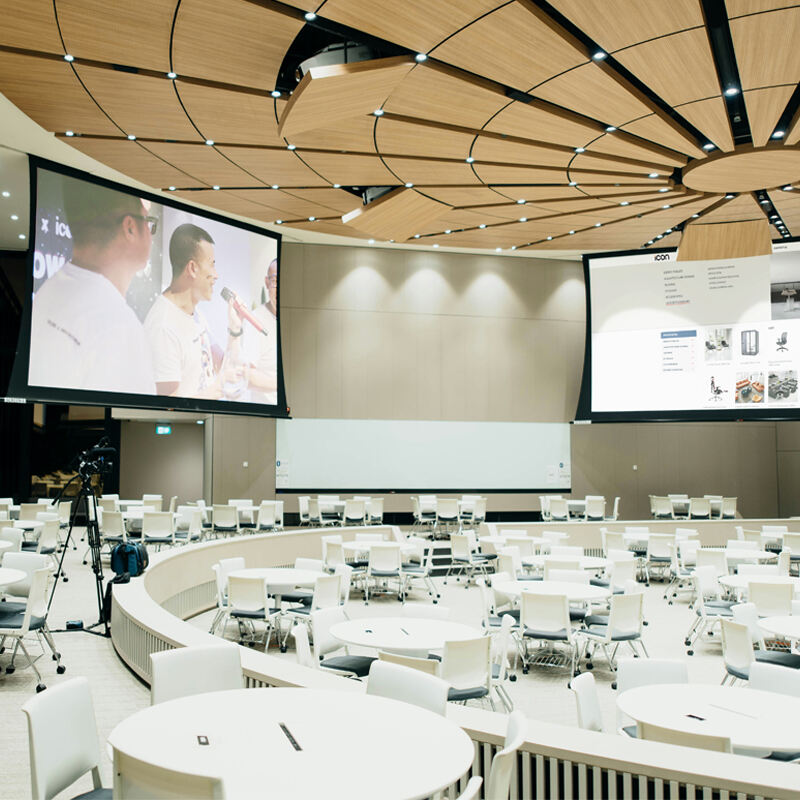Nykyaikaisten työpaikkatietokonejärjestelmien kehitys
Nykyajan toimistoympäristö on muuttunut huomattavasti, ja toimistotyöasema on muodostunut ammattimaiseksi tuottavuuden perustaksi. työasemat nämä kehittyneet tietokonelaitteet ovat paljon enemmän kuin pelkkä kirjoituspöytä tietokoneineen – ne muodostavat monimutkaisen ekosysteemin, joka on suunniteltu maksimoimaan tehokkuus, mukavuus ja suorituskyky nykyaikaisessa työympäristössä.
Nykyään toimistotyöasema kattaa kaiken uusimmasta laitteistokonfiguraatiosta ergonomisiin huonekaluratkaisuihin, ja luo näin ympäristön, jossa ammattilaiset voivat päästä parhaimpaan suoritukseen. Kun organisaatiot yhä enemmän tunnistavat työaseman laadun ja työntekijöiden tuottavuuden välisen suoran yhteyden, korkean suorituskyvyn järjestelmien sijoittaminen on muodostunut strategiseksi prioriteetiksi.
Tärkeimmät laitteistokomponentit huippusuoritukseen
Suorituskyky ja muistikokoonpano
Jokaisen korkean suorituskyvyn toimistotyöaseman sydämessä on sen laskentakapasiteetti. Nykyaikaiset ammattitehtävät vaativat tehokasta prosessoritehoa, yleensä moniydinprosessorit, jotka voivat käsitellä useita sovelluksia samanaikaisesti. Ihanteellinen toimistotyöasema sisältää vähintään 16 Gt RAM-muistia sulavan monitaskauksen takaamiseksi, ja mahdollisuus päivitykseen tulisi olla saatavilla kasvavien vaatimusten mukaan.
Säilytys ratkaisut ovat yhtä tärkeässä asemassa, ja kiintolevyasemat (SSD:t) ovat muodostuneet standardiksi ensisijaisessa tallennuksessa. Nämä asemat vähentävät huomattavasti latausaikoja ja parantavat järjestelmän kokonaisvastea, mikä mahdollistaa ammattilaisten pääsyn tiedostoihin ja sovelluksiin ilman ärsyttäviä viiveitä.
Näyttötekniikka ja visuaalinen suorituskyky
Ammattiluokan näytöt ovat keskeisiä komponentteja kaikissa suorituskykyisissä toimistotyöasemissa. Moninäyttöjärjestelmät ovat yleistyneet entisestään tarjoten laajempaa näyttötilaa, joka lisää tuottavuutta useita ikkunoita tai sovelluksia vaativissa tehtävissä. Nykyaikaisissa näytöissä tulisi olla korkea resoluutio, tarkka värintoisto ja silmien kuormitusta vähentävät ominaisuudet, kuten heijastumisen esto, jotta silmänpäälle saadaan riittävä helpotus pitkien käyttöjaksojen aikana.
Toimiston työaseman graafiset ominaisuudet on sovitettava sen tarkoitukseen, olipa kyse perusasiakirjojen käsittelystä tai vaativista visuaalisista tehtävistä, kuten 3D-mallinnuksesta tai videonmuokkauksesta. Ammattilaiskäyttöön tarkoitetut näytönohjaimet varmistavat saumattoman suorituskyvyn kaikissa visuaalisissa sovelluksissa ja tukevat useita korkearesoluutioisia näyttöjä.
Ergonominen suunnittelu ja työtilan optimointi
Kalusteet ja fyysinen järjestely
Korkean suorituskyvyn toimiston työasema on suunniteltava käyttäjän mukavuuden kannalta ergonomian periaatteiden mukaisesti. Tähän kuuluu korkeussäädettävät työtiskit, jotka mahdollistavat sekä istumalla että seisten työskentelyn, edistäen parempaa kehon asentoa ja vähentäen terveysriskejä, joita liittyy pitkään istumiseen. Työtilan tulisi tarjota riittävästi pinta-alaa keskeisille laitteille samalla kun se säilyttää siistin ja järjestellyn ilmeen.
Tuolin valinta on ratkaisevan tärkeää, ja asianmukainen lannerangan tuki, säädettävät käsijalat sekä korkeussäätö ovat välttämättömiä ominaisuuksia. Näppäimistön, hiiren ja näyttöjen sijoittelun tulisi noudattaa ergonomisia ohjeita, jotta toistuvien rasitusvammojen riski vähenee ja työpäivän ajan säilyy optimaalinen mukavuus.

Kaapelinhallinta ja järjestely
Ammattimaiset toimistotyöasemat edellyttävät harkittuja kaapelinhallintaratkaisuja, jotta toiminnallisuus ja ulkonäkö säilyvät tasossa. Integroidut kaapelikiskot, reitityskaistaleet ja työpöydän rei'ittimet auttavat pitämään virta- ja datakaapelit järjestyksessä ja suojassa. Tämä ei ainoastaan paranna ulkonäköä, vaan myös lisää turvallisuutta ja helpottaa huoltoa.
Yhteydet ja verkkointegrointi
Langattomat ja langalliset ratkaisut
Modernien toimistotyöasemien on tarjottava tehokkaat yhteydenpito-ominaisuudet erilaisten laitteiden ja verkkoyhteyksien tukemiseksi. Nopeat ethernet-portit tarjoavat luotettavan langallisen yhteyden, kun taas langaton toiminnallisuus mahdollistaa joustavuuden ja vähentää kaapelihelppyyttä. Bluetooth-teknologian integrointi mahdollistaa saumattoman yhteyden langattomiin laitteisiin ja matkapuhelimiin.
USB-portit, erityisesti USB-C Thunderbolt-tuen kanssa, ovat olennaisia ulkoisten laitteiden liittämiseksi ja työaseman tulevaisuudensuuntautumiseksi. Dockkaukset voivat laajentaa yhteydenpito-ominaisuuksia samalla kun ne säilyttävät siistin työpöydän ympäristön.
Verkon turvallisuus ja pääsy
Turvallisuusominaisuudet ovat keskeisiä komponentteja jokaisessa toimistotyöasemassa, mukaan lukien laitepohjainen salaus, suojattu käynnistysmahdollisuus ja biometriset tunnistautumisvaihtoehdot. Verkkointegroinnin on sisällettävä tehokas palomuurisuojaus ja turvallinen VPN-pääsy etätyöskentelytilanteisiin.
Mukautus- ja skaalausvaihtoehdot
Laitteen päivitettävyys
Hyvin suunniteltu toimistotyöasema tulisi tarjota selkeät päivitysreitit tulevaa laajennusta varten. Tähän kuuluvat helposti saatavilla olevat muistikorttipaikat, lisätilan asennusmahdollisuudet sekä laajennettavissa olevat grafiikkavaihtoehdot. Komponenttien päivittämismahdollisuus varmistaa, että työasema voi kehittyä muuttuvien ammattilaisten tarpeiden mukana ilman, että se täytyy vaihtaa kokonaan uuteen.
Ohjelmisto- ja järjestelmäjoustavuus
Käyttöjärjestelmän valinta ja ohjelmistoyhteensopivuus ovat ratkaisevan tärkeitä näkökohtia. Työaseman tulisi tukea erilaisia ammattikäyttöön tarkoitettuja ohjelmistopaketteja ja mahdollistaa helppo järjestelmän päivitys ja ylläpito. Virtualisointiominaisuudet voivat tarjota lisäjoustavuutta useiden käyttöjärjestelmien tai eristettyjen testiympäristöjen ajamiseen.
Usein kysytyt kysymykset
Mikä on optimaalinen näyttöasettelu toimistotyöasemalle?
Optimaalinen näyttöasetus sisältää yleensä kaksi tai kolme näyttöä, joista jokaisella on vähintään 24 tuumaa halkaisijaltaan ja 1440p-resoluutio. Harkitse laajakuvaruutunäyttöjä sellaisiin työnkulkuihin, joissa hyödytään lisätystä vaakasuorasta tilasta. Varmista oikea sijoitus silmien korkeudelle ja kyynärpään pituuden päässä.
Kuinka usein toimistotyöaseman tulisi päivittää?
Tärkeimmät laitteistokomponentit tulisi arvioida joka kolmas–neljäs vuosi, ja päivitykset tulisi toteuttaa suorituskyvyn vaatimusten ja teknologisen kehityksen mukaisesti. Säännöllisiä ohjelmistopäivityksiä ja huoltoa tulisi suorittaa jatkuvasti optimaalisen suorituskyvyn ylläpitämiseksi.
Mitkä ovat olennaiset ergonomiset ominaisuudet toimistotyöasemalle?
Olenelliset ergonomiset ominaisuudet sisältävät säädettävän tuolin, jossa on asianmukainen lannerangansija, korkeussäädettävän kirjoituspöydän, ergonomisen näppäimistön ja hiiren, oikean näytön korkeuden ja etäisyyden sekä riittävän valaistuksen. Nämä elementit toimivat yhdessä oikean asennon edistämiseksi ja fyysisen kuormituksen vähentämiseksi pitkien työistuntojen aikana.





